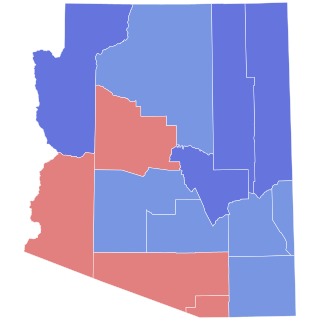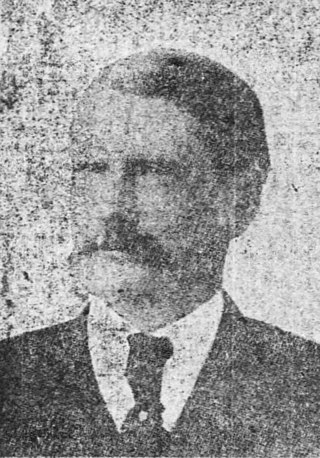
From February 10 to June 9, 1992, voters of the Democratic Party chose its nominee for president in the 1992 United States presidential election. Despite scandals and questions about his character, Arkansas Governor Bill Clinton won the nomination through a series of primary elections and caucuses culminating in the 1992 Democratic National Convention held from July 13 to July 16, 1992, in New York City. Clinton and Tennessee Senator Al Gore were nominated by the convention for president and vice president, respectively.

Marcus Aurelius Smith was an American attorney and politician who served eight terms as Arizona Territorial Delegate to Congress and as one of the first two Senators from Arizona. As a Delegate, he was a leader in the effort to gain statehood for Arizona. His non-voting status, however, minimized his influence with only 35 of the 277 bills he introduced into the House of Representatives being signed into law. Lack of a voice in the United States Senate further weakened his efforts as he managed to get Arizona statehood bills passed by the House only to see the legislation blocked in the Senate. Beyond his efforts for statehood, Smith worked to have government buildings constructed and to provide relief to his constituents affected by either man-made or natural misfortunes. His efforts to provide relief to the citizens of Arizona did not extend to the indigenous population, for whom Smith expressed great animosity.

The 1912–13 United States Senate elections were held on various dates in various states. They were the last U.S. Senate elections before the ratification of the Seventeenth Amendment in 1913, establishing direct elections for all Senate seats. Senators had been primarily chosen by state legislatures. Senators were elected over a wide range of time throughout 1912 and 1913, and a seat may have been filled months late or remained vacant due to legislative deadlock. Some states elected their senators directly even before passage of Seventeenth Amendment. Oregon pioneered direct election and experimented with different measures over several years until it succeeded in 1907. Soon after, Nebraska followed suit and laid the foundation for other states to adopt measures reflecting the people's will. By 1912, as many as 29 states elected senators either as nominees of their party's primary or in conjunction with a general election.

Sonia Rosa Chang-Díaz is an American politician who served in the Massachusetts Senate from the 2nd Suffolk district as a member of the Democratic Party. She was the first Hispanic woman elected to the state senate. She ran for the Democratic nomination for Governor of Massachusetts in the 2022 election.

The 1914 Arizona gubernatorial election took place on November 3, 1914, for the post of the Governor of Arizona. The Supreme Court of Arizona ruled that there would be no statewide elections in 1912, thus extending the terms to sync up with elections on even years. The Democratic nominee was incumbent governor George W. P. Hunt, his Republican opponent was the final Delegate to Congress from Arizona Territory, Ralph H. Cameron. Cameron was disadvantaged by the same reason the previous Republican nominee Wells was: he had opposed statehood with the present Constitution.

The 1926 Arizona gubernatorial election took place on November 2, 1926. Despite being a Democratic year generally, Hunt barely managed to be re-elected against his Republican opponent Elias Clark. Hunt had been governor for around 11 out of the State of Arizona's 14 years, coupled with his age and with issues regarding the Colorado River Compact, he was running out of steam. Despite that Hunt narrowly prevailed and won.

The 1930 Arizona gubernatorial election took place on November 4, 1930. George W. P. Hunt narrowly won the general election in 1930, defeating incumbent governor John Calhoun Phillips, who had defeated Hunt in his bid for reelection in the previous election year in 1928.

The 1932 Arizona gubernatorial election took place on November 8, 1932. Incumbent Governor George W. P. Hunt ran for the Democratic nomination, but lost in the primary to Benjamin Baker Moeur, whose pre-gubernatorial experience included service as the Secretary of the Board of Education for Arizona State Teacher's College, which would later become Arizona State University.

The 1934 Arizona gubernatorial election took place on November 6, 1934. Incumbent Governor Benjamin Baker Moeur ran for reelection, he was challenged by former governor George W. P. Hunt and future Governor Rawghlie Clement Stanford in the Democratic primary, but he defeated both of them by a comfortable margin.

Fred Tuttle Colter was an Arizona rancher and farmer, as well as being the state senator for Apache County beginning with Arizona's second state legislature in 1915. Colter spent six terms in the Arizona Senate. He also led the fight on Arizona's behalf to maintain control over the water from the Colorado River, coining the slogan, "Save the Colorado for Arizona". He was a close ally of the state's first governor, George W. P. Hunt. Prior to his election to the state senate, Colter had served as the state's fair commissioner.

Fred Arthur Sutter Sr. was an Arizona attorney and politician. He ran several times, unsuccessfully, for governor of the state, and was elected several times to the state legislature.

The 1918 United States Senate election in Michigan took place on November 5, 1918. Incumbent Republican Senator William Alden Smith did not seek re-election to a third term in office. In the race to succeed him, Republican former Secretary of the Navy Truman Handy Newberry defeated the automobile industrialist Henry Ford. Ford first challenged Newberry in the Republican primary and lost and then faced Newberry again, running as the Democratic nominee in the general election.

William Prescott Sims ) was a politician and dentist from Arizona. He served in Arizona State Senate in the 1st, 2nd, and 5th - 7th State Legislatures. He served as the President of the Senate during the 2nd Legislature.

Charles M. Roberts was an American politician who served in the first Arizona State Senate.

William Monroe Riggs was a politician from Arizona who served in the Arizona state senate during the 2nd Arizona State Legislature. He was a cattleman in southern Arizona, and served on the Cochise County board of supervisors for several terms, being chairman for four years, and was elected to the Arizona state senate.

Hugh E. Campbell was a politician from Arizona who served in the Arizona state senate for four terms. He was the Arizona Democrat delegate to their national convention in 1896. He was one of the largest sheep ranchers in Arizona, and was prominent in both the National Wool Growers Association and the National Livestock Association. For six years he served on the board of the Arizona State Fair commission, five as its president.

David Harmon Claridge was a politician from Arizona who served in the Arizona Senate for several terms. He was also a rancher, a farmer, and an Arizona pioneer. In the 1920s he stopped ranching and moved to Phoenix, where he became involved in the real estate business.

William P. Mahoney was an American lawyer and politician who served in the Arizona House of Representatives from 1915 to 1916 and in the Arizona Senate from 1917 to 1918, as a member of the Democratic Party. After his tenure in the state legislature he served as the sheriff of Mohave County, Arizona.

Anthony A. Johns was an American politician from Arizona. He served a single term in the Arizona State Senate during the 4th Arizona State Legislature, holding one of the two seats from Yavapai County, as well as serving as President of the Senate. He also held one of the seats from Yavapai County in the Arizona House of Representatives three times, in the 2nd, 3rd and 13th Arizona State Legislatures, serving as the Speaker of the House during the 3rd Legislature. He was a long-time resident of Prescott, and one of the largest sheepherders in Yavapai County. Other business interests included mining and construction. Other offices held included a regent for the University of Arizona, chairman of the Arizona Highway Commission, chief of the Prescott Fire Department, president of the Arizona Wool Growers Association, and vice-president of the National Wool Growers Association.
John P. Cull was an American politician from Arizona. He served several terms in the Arizona State Legislature, beginning in Arizona House of Representatives during the 4th Arizona State Legislature, and then in the Arizona State Senate first in the 5th Arizona State Legislature, and again in the 10th Arizona State Legislature. In both of his re-election attempts to the State Senate he was defeated in the Democrat's primary. During his career he was involved in the banking and mercantile industries, and later on was one of the largest cattle ranchers in Cochise County. During the 1930s he also served on the Arizona State Livestock Sanitary Board.






















